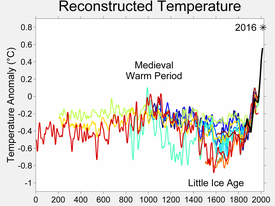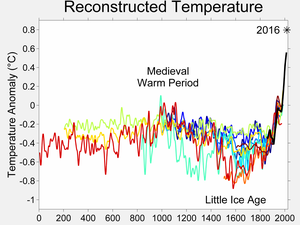Navigation
Install the app
How to install the app on iOS
Follow along with the video below to see how to install our site as a web app on your home screen.

Note: This feature currently requires accessing the site using the built-in Safari browser.
More options
You are using an out of date browser. It may not display this or other websites correctly.
You should upgrade or use an alternative browser.
You should upgrade or use an alternative browser.
Here's an interesting study..
- Thread starter westwall
- Start date
Sunsettommy
Diamond Member
- Mar 19, 2018
- 14,892
- 12,526
- 2,400
Neither the MWP nor the LIA were global in extent.
Ha ha ha,...... you are so bad at this.
I posted a source that has over 100 published papers showing that MWP was indeed found in many parts of the world. You just ignored 34 papers in china alone and ignored 27 more for South America. You ignored 9 papers for Antarctica and 6 more for Australia.
It was found in a number of places in the Southern Hemisphere, you can't make the published papers vanish.
Sunsettommy
Diamond Member
- Mar 19, 2018
- 14,892
- 12,526
- 2,400
Many is not all, and they were not at the same time. MWP and LIA were not global phenomena.
It wasn't all at the same time North America either.
I made a case for it you haven't at all.
- Dec 18, 2013
- 136,283
- 27,871
- 2,180
Peer review.....OK, post them if they are from peer reviewed scientific journals. If the are from shit sites like WUWT, forget it.I just realized there are no hockey sticks in any of those graphing's..
I know of a lot of papers that have ZERO hockey sticks in them, they cover regions of the planet. Many show little to no warming in them.
Warmists in this forum show strong allergic reactions to published papers I post, it seems they can't handle it.



Many is not all, and they were not at the same time. MWP and LIA were not global phenomena.
It wasn't all at the same time North America either.
I made a case for it you haven't at all.
Making a case for it is not difficult
From Wikipedia, with references

Northern hemisphere temperature reconstructions for the past 2,000 years
The Medieval Warm Period (MWP) also known as the Medieval Climate Optimum, or Medieval Climatic Anomaly was a time of warm climate in the North Atlantic region that may have been related to other warming events in other regions during that time, including China[1] and other areas,[2][3] lasting from c. 950 to c. 1250.[4] Other regions were colder, such as the tropical Pacific. Averaged global mean temperatures have been calculated to be similar to early-mid 20th century warming. Possible causes of the Medieval Warm Period include increased solar activity, decreased volcanic activity, and changes to ocean circulation.[5]
References
- Li, H.; Ku, T. (2002). "Little Ice Age and Medieval Warm Periods in Eastern China as Read from the Speleothem Records". American Geophysical Union. 71: 09. Bibcode:2002AGUFMPP71C..09L.
- Grove, Jean M.; Switsur, Roy (1994). "Glacial geological evidence for the medieval warm period" (PDF). Climatic Change. 26 (2–3): 143. doi:10.1007/BF01092411.
- Diaz, Henry F.; Hughes, M. (1994). The Medieval warm period. Boston: Kluwer Academic Publishers. p. 134. ISBN 0-7923-2842-6. 6.2 Evidence for a Medieval Warm Epoch
- Mann, M. E.; Zhang, Z.; Rutherford, S.; et al. (2009). "Global Signatures and Dynamical Origins of the Little Ice Age and Medieval Climate Anomaly" (PDF). Science. 326 (5957): 1256–60. Bibcode:2009Sci...326.1256M. doi:10.1126/science.1177303. PMID 19965474.
- "How does the Medieval Warm Period compare to current global temperatures?". SkepticalScience. Retrieved October 12, 2017.

The reconstructed depth of the Little Ice Age varies between different studies (anomalies shown are from the 1950–80 reference period)
The Little Ice Age (LIA) was a period of cooling that occurred after the Medieval Warm Period.[1] Although it was not a true ice age, the term was introduced into scientific literature by François E. Matthes in 1939.[2] It has been conventionally defined as a period extending from the 16th to the 19th centuries,[3][4][5] but some experts prefer an alternative timespan from about 1300[6] to about 1850.[7][8][9] Climatologists and historians working with local records no longer expect to agree on either the start or end dates of the period, which varied according to local conditions.
References
- Ladurie, Emmanuel Le Roy (1971). Times of Feast, Times of Famine: a History of Climate Since the Year 1000. Barbara Bray. Garden City, NY: Doubleday. ISBN 0-374-52122-0. OCLC 164590.
- Matthes, F.E. (1939). "Report of the committee on glaciers". Transactions of the American Geophysical Union: 518–23.Matthes described glaciers in the Sierra Nevada of California that he believed could not have survived the hypsithermal; his usage of "Little Ice Age" has been superseded by "Neoglaciation".
- Mann, Michael (2003). "Little Ice Age". In Michael C MacCracken; John S Perry. Encyclopedia of Global Environmental Change, Volume 1, The Earth System: Physical and Chemical Dimensions of Global Environmental Change (PDF). John Wiley & Sons. Retrieved 17 November 2012.
- Lamb, HH (1972). "The cold Little Ice Age climate of about 1550 to 1800". Climate: present, past and future. London: Methuen. p. 107. ISBN 0-416-11530-6. (noted in Grove 2004:4).
- "Earth observatory Glossary L-N". NASA Goddard Space Flight Center, Green Belt MD: NASA. Retrieved 17 July 2015.
- Miller et al. 2012. "Abrupt onset of the Little Ice Age triggered by volcanism and sustained by sea-ice/ocean feedbacks" Geophysical Research Letters 39, 31 January: abstract (formerly on AGU website) (accessed via wayback machine 11 July 2015); see press release on AGU website(accessed 11 July 2015).
- Grove, J.M., Little Ice Ages: Ancient and Modern, Routledge, London (2 volumes) 2004.
- Matthews, J.A. and Briffa, K.R., "The 'Little Ice Age': re-evaluation of an evolving concept", Geogr. Ann., 87, A (1), pp. 17–36 (2005). Retrieved 17 July 2015.
- Solar Variability and the Total Solar Irradiance – AR4 WGI Chapter 1: Historical Overview of Climate Change Science". Ipcc.ch. Retrieved 24 June 2013.
Similar threads
- Replies
- 117
- Views
- 2K
- Replies
- 95
- Views
- 1K
- Replies
- 39
- Views
- 961
Latest Discussions
- Replies
- 26
- Views
- 130
- Replies
- 13
- Views
- 40
- Replies
- 92
- Views
- 628
Forum List
-
-
-
-
-
Political Satire 8029
-
-
-
-
-
-
-
-
-
-
-
-
-
-
-
-
-
-
-
ObamaCare 781
-
-
-
-
-
-
-
-
-
-
-
Member Usernotes 468
-
-
-
-
-
-
-
-
-
-